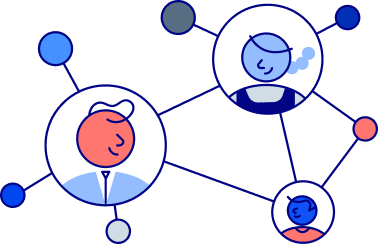This blog post was co-authored by Aaron Blumberg, Partner & Attorney at Fragomen.
The U.S. has many visas for temporary workers or non-immigrants. In this post, we will focus on the most common employment-based U.S. visa: the H-1B. This is an employer-sponsored visa, so it’s vital for employers to understand H-1B visas before beginning the hiring process for a foreign national.
What Is an H-1B?
H-1B visas are open to professionals working in a specialty occupation who are sponsored by a U.S. employer. The visa grants work authorization to a foreign national for up to six years. The visa holder can work part-time or full-time. To be considered a specialty occupation, usually a bachelor’s degree or higher is required. The H-1B is a dual intent visa, which means the worker can apply for permanent residency while on the visa if you wish to remain in the U.S. long term.
H-1B visas are allocated using a lottery system for certain employers. Each year, there are 65,000 H-1B visas available for employers that have to apply through the lottery. 6,800 of those visas are set aside for professionals from Chile and Singapore. There is high demand for H-1B visas, so luck is a factor in this lottery system.
An additional 20,000 H-1B visas are available for those with an advanced degree from a U.S. university. There is less competition for these visas, so it may be advantageous to recruit international graduate school students. The following employers are exempt from the lottery cap and can request as many H-1B visas as they need:
- Non-profit colleges and universities
- Non-profit organizations affiliated with colleges and universities
- Nonprofit and government research entities
How to Apply as a Sponsor for H-1B Visas
Applying to sponsor employees with H-1B visas for the first time may seem overwhelming with the number of forms to complete and abbreviations to learn. To help demystify the process, we have broken it down into four easy steps.
- Register for the lottery in early March through USCIS. You will be notified if you are selected by the end of March. If you plan to hire more than one foreign national, you can register them all under the same submission. You can register up to 250 employees in one submission and complete as many submissions as needed. It costs $10 per employee you will sponsor to enter the lottery.
- Once selected in the lottery, get your Labor Condition Application (LCA) certified by the DOL. It generally takes eight days to process the LCA. You must notify current employees that the LCA was filed, and employees should be allowed to review it upon request. The purpose of the LCA is to prove that you can pay the prevailing wage for the specific occupation in that area and show that hiring an H-1B worker will not negatively affect American workers.
- File your H-1B petition with USCIS between April 1 and June 30. Here is the information needed to file:
- Company name and address
- Name, title, and contact information of authorized signatory
- Documentation of your company’s operations such as an annual report or business model
- Job title of the H-1B worker’s position
- Address of the work site
- Starting salary
- Minimum requirements and detailed job duties for the position
- Pay H-1B fees to USCIS. The basic fees are approximately $960, and additional fees may apply to some employers. For an extra $2,500, you can purchase expedited processing so that your H-1B visa petition is granted within 15 calendar days. With standard processing, it could take up to eight months for the visa to be approved.
When Can a Foreign National Start Working in the U.S.?
Once your H-1B visa request is approved, your new hires can start working on October 1st or later, but no sooner than that. If the employee is currently working for you under another visa status such as OPT with an F-1 visa, there may be a gap in their work authorization between the end of the authorized OPT employment and October 1st. International students who are on OPT or STEM OPT may be eligible for a Cap-Gap Extension so that they can continue working for you through October 1st.
Can I Hire Someone Already on an H-1B Visa?
Foreign nationals are free to change jobs in the U.S., so it is possible that you may want to hire someone who is already working on an H-1B visa for another company. To hire this worker, you must file an H-1B change of employer petition. If the employee was already subject to the H-1B lottery, they do not have to participate in the lottery again for the new job. An employee going from a cap-exempt position to a cap-subject position can be tricky. Contact Fragomen’s immigration experts for assistance.
Preparation for a change of employer petition takes about 2-3 weeks. Processing the change often takes up to six months, but the new hire can start working for you after the petition is filed with USCIS, before it is actually approved. You can also pay $2,500 for expedited processing. Lastly, keep in mind that the H-1B visa only lasts six years even if the foreign national switches employers.
H-1B Amendments
To change the employee’s position, job site, or other material job details, you must file an amendment to USCIS. You should submit the amendment before making the change, but you don’t have to wait for approval to implement the change. As always, expedited processing is available for $2,500.
You may need to submit an H-1B amendment if your H-1B employee is:
- Given a promotion
- Given different hours such as switching from part-time or full-time
- Relocated to work in a different city or state
- Given significantly different job responsibilities
H-1B Status and Compliance
Employees who quit their job will have to leave the U.S. within 60 days (or when their I-94 expires, whichever is sooner) or find alternative work authorization. You can hire someone with H-1B status who already left their previous job as long as it is still within the 60-day grace period.
When an H-1B employee leaves or is let go from your company, withdraw the H-1B visa by sending a letter to USCIS. If you fire or lay off the employee, you will be required to offer to pay for their return transportation to their home country. This stipulation does not apply if the employee leaves voluntarily.
There are a few other stipulations that employers must follow to stay in compliance with their H-1B status:
- H-1B employees cannot be placed on forced unpaid leave such as furloughs.
- H-1B employees must be eligible for the same pre-approved, voluntary leave of absences as other non-H-1B employees such as maternity leave.
International Travel for H-1B Workers
Employees on an H-1B visa must have a valid visa stamp in their passport to re-enter the U.S. after traveling abroad even if it’s just for a holiday. Make sure to inform your H-1B employees of this when onboarding them. They should contact their legal counsel before they leave the country to ensure they will not get stuck outside the U.S.
The H-1B visa stamp which is utilized to re-enter the U.S. must be obtained at a U.S. consulate outside of the country (i.e. after the foreign national has already left the country). Some consulates have considerable wait times to get a new stamp. This could cause employees to miss work while they are waiting to return. Canadian citizens are exempt from this requirement and can travel freely with an approved H-1B I-797 notice.
Key Takeaways for Employers
The path to sponsoring H-1B visa holders can be complicated, and planning ahead is crucial. The deadlines are strict and if you miss them, you will have to wait another year before you can apply again. If you are selected in the lottery, be precise and thorough when preparing documents and applying to sponsor H-1B workers.
In recent years, the H-1B petition approval rates have been increasing, so if you meet all the requirements and are selected in the lottery, you have a good chance of approval. 97.3% of H-1B petitions were approved in 2021. Sometimes, DOL or USCIS may request additional evidence to determine qualification for an H-1B visa. Make sure to respond to requests for additional information promptly.
| H-1B Pros: | H-1B Cons: |
|
|
Because chances of winning the H-1B lottery are still low, it’s valuable to explore other options to hire foreign nationals. Alternative options include:
- Country-specific work visas: TN, H-1B1, and E-3
- Intracompany transfer visa: L-1
- Visas for treaty traders and investors: E-1 and E-2
- Visas for those with extraordinary ability: O-1
- Another academic program such as graduate school, which could provide CPT or OPT employment opportunities
Learn more about these alternatives to H-1B visas for international students and graduates from Interstride’s blog.
Fragomen Can Help You Sponsor Your First H-1B
Want more personalized guidance on sponsoring H-1B employees for the first time? Contact Fragomen for professional assistance. Fragomen’s experts have decades of experience navigating the complex U.S. immigration system. They can complete the H-1B paperwork for you and advise you on compliance and your employee on their rights to ensure a smooth application process.























